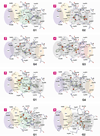Discovery of new scaffolds for rational design of HCV NS5B polymerase inhibitors
- PMID: 23127989
- PMCID: PMC3513558
- DOI: 10.1016/j.ejmech.2012.09.010
Discovery of new scaffolds for rational design of HCV NS5B polymerase inhibitors
Abstract
Hepatitis C virus (HCV) NS5B polymerase is a key target for the development of anti-HCV drugs. Here we report on the identification of novel allosteric inhibitors of HCV NS5B through a combination of structure-based virtual screening and in vitro NS5B inhibition assays. One hundred and sixty thousand compounds from the Otava database were virtually screened against the thiazolone inhibitor binding site on NS5B (thumb pocket-2, TP-2), resulting in a sequential down-sizing of the library by 2.7 orders of magnitude to yield 59 NS5B non-nucleoside inhibitor (NNI) candidates. In vitro evaluation of the NS5B inhibitory activity of the 59 selected compounds resulted in a 14% hit rate, yielding 8 novel structural scaffolds. Of these, compound 1 bearing a 4-hydrazinoquinazoline scaffold was the most active (IC(50) = 16.0 μM). The binding site of all 8 NNIs was mapped to TP-2 of NS5B as inferred by a decrease in their inhibition potency against the M423T NS5B mutant, employed as a screen for TP-2 site binders. At 100 μM concentration, none of the eight compounds exhibited any cytotoxicity, and all except compound 8 exhibited between 40 and 60% inhibition of intracellular NS5B polymerase activity in BHK-NS5B-FRLuc reporter cells. These inhibitor scaffolds will form the basis for future optimization and development of more potent NS5B inhibitors.
Copyright © 2012 Elsevier Masson SAS. All rights reserved.
Figures

Similar articles
-
2-Heteroarylimino-5-arylidene-4-thiazolidinones as a new class of non-nucleoside inhibitors of HCV NS5B polymerase.Eur J Med Chem. 2013 Nov;69:931-41. doi: 10.1016/j.ejmech.2013.08.043. Epub 2013 Sep 12. Eur J Med Chem. 2013. PMID: 24161679 Free PMC article.
-
Structure-based virtual screening, synthesis and SAR of novel inhibitors of hepatitis C virus NS5B polymerase.Bioorg Med Chem. 2010 Jul 1;18(13):4630-8. doi: 10.1016/j.bmc.2010.05.030. Epub 2010 May 15. Bioorg Med Chem. 2010. PMID: 20627595 Free PMC article.
-
Combining 3-D quantitative structure-activity relationship with ligand based and structure based alignment procedures for in silico screening of new hepatitis C virus NS5B polymerase inhibitors.J Chem Inf Model. 2010 Apr 26;50(4):662-76. doi: 10.1021/ci9004749. J Chem Inf Model. 2010. PMID: 20225870
-
2-hydroxy-1-oxo-1,2-dihydroisoquinoline-3-carboxylic acid with inbuilt β-N-hydroxy-γ-keto-acid pharmacophore as HCV NS5B polymerase inhibitors.Curr Med Chem. 2012;19(4):613-24. doi: 10.2174/092986712798918833. Curr Med Chem. 2012. PMID: 22204334 Review.
-
Recent advances on the synthesis of hepatitis C virus NS5B RNA-dependent RNA-polymerase inhibitors.Eur J Med Chem. 2015 Sep 18;102:188-214. doi: 10.1016/j.ejmech.2015.07.046. Epub 2015 Jul 31. Eur J Med Chem. 2015. PMID: 26276434 Review.
Cited by
-
Discovery of Novel Hepatitis C Virus NS5B Polymerase Inhibitors by Combining Random Forest, Multiple e-Pharmacophore Modeling and Docking.PLoS One. 2016 Feb 4;11(2):e0148181. doi: 10.1371/journal.pone.0148181. eCollection 2016. PLoS One. 2016. PMID: 26845440 Free PMC article.
-
2-Heteroarylimino-5-arylidene-4-thiazolidinones as a new class of non-nucleoside inhibitors of HCV NS5B polymerase.Eur J Med Chem. 2013 Nov;69:931-41. doi: 10.1016/j.ejmech.2013.08.043. Epub 2013 Sep 12. Eur J Med Chem. 2013. PMID: 24161679 Free PMC article.
-
Design and synthesis of L- and D-phenylalanine derived rhodanines with novel C5-arylidenes as inhibitors of HCV NS5B polymerase.Bioorg Med Chem. 2013 Jun 1;21(11):3262-71. doi: 10.1016/j.bmc.2013.03.041. Epub 2013 Mar 31. Bioorg Med Chem. 2013. PMID: 23598249 Free PMC article.
-
The IQA Energy Partition in a Drug Design Setting: A Hepatitis C Virus RNA-Dependent RNA Polymerase (NS5B) Case Study.Pharmaceuticals (Basel). 2022 Oct 8;15(10):1237. doi: 10.3390/ph15101237. Pharmaceuticals (Basel). 2022. PMID: 36297349 Free PMC article.
-
Discovery of the 2-phenyl-4,5,6,7-Tetrahydro-1H-indole as a novel anti-hepatitis C virus targeting scaffold.Eur J Med Chem. 2015;96:250-8. doi: 10.1016/j.ejmech.2015.04.022. Epub 2015 Apr 10. Eur J Med Chem. 2015. PMID: 25890075 Free PMC article.
References
-
- Seeff LB. Dilemma of the natural history of hepatitis C. J. Gastroenterol Hepatol. 1999;14:199–201. - PubMed
-
- Shepard CW, Finelli L, Alter MJ. Global epidemiology of hepatitis C virus infection. Lancet Infect. Dis. 2005;5:558–567. - PubMed
-
- Dillon JF. Hepatitis C: What is the best treatment? J. Viral Hepat. 2004;11(Suppl 1):23–27. - PubMed
-
- Ni ZJ, Wagman AS. Progress and development of small molecule HCV antivirals. Curr. Opin. Drug Discov. Devel. 2004;7:446–459. - PubMed
-
- Cornberg M, Wedemeyer H, Manns MP. Treatment of chronic hepatitis C with PEGylated interferon and ribavirin. Curr. Gastroenterol. Rep. 2002;4:23–30. - PubMed
Publication types
MeSH terms
Substances
Grants and funding
LinkOut - more resources
Full Text Sources
Other Literature Sources

